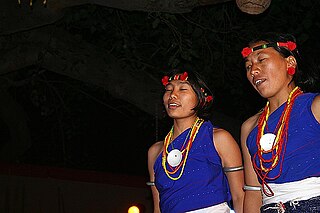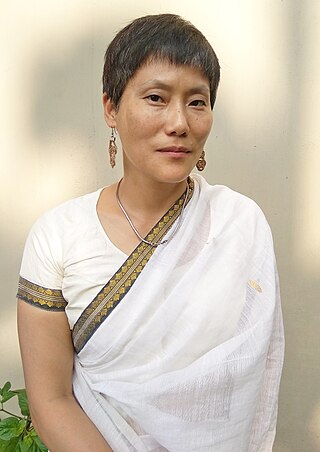Gallery
- A Lotha Naga girl in her traditional attire
| Total population | |
|---|---|
| 173,111 [1] (2011 census) | |
| Languages | |
| Lotha language (Sino–Tibetan) | |
| Religion | |
| Christianity (chiefly Baptist) | |
| Related ethnic groups | |
| other Naga Ethnic Groups |
The Lothas, also known as Kyongs are a major Naga ethnic group native to Wokha District in the Northeast Indian state of Nagaland.
Scholars have presented several theories about the migration of the Lothas and the other Naga people, based on vocal explanations passed on from one generation to another.
According to this theory mentioned by Hokishe Sema, the Lothas started moving out from the Eastern part of China, passing through Malaysia, Indonesia and Burma en route. After many long years of movement, they reached a place called Khezakhenoma located between Manipur and Chakhesang (the present-day Phek), where they settled for a short period of time. From Khezakhenoma they moved towards the present day settlement of the Lothas i.e. Wokha where they finally settled. [2]
This theory, mentioned by T. Phillips, says that the Lothas migrated from Manchuria, passing through the foothills of the Himalayas and reached Manipur via Burma. From Manipur, they moved out and settled at the present day place. [3]
There are multiple versions of this theory: [4]
Local traditions mention that the Rengmas and the Lothas were once part of a single ethnic groups. [5] There are also oral records of a mighty struggle between the combined Rengma villages, and the Lotha village of Phiro. [6]
Beyond Wokha District, there are also sizable Lotha inhabitants in Kohima, Chümoukedima, Dimapur and Medziphema.
Wokha District is the traditional home of the Lotha Nagas. The Lothas are renowned for their colorful dances and folk songs. The male members wear shawls indicating their social status. The prestigious social shawl for women is Opvüram and Longpensü for men.
Like many Nagas, the Lothas practiced headhunting in the older days. After the arrival of Christianity, they gave up this practice. Though the majority of the Lothas are Baptist, there exist a moderate amount of other forms of Christianity like the Catholics. Catholics are concentrated more in Wokha than in other parts of Nagaland.
Tokhü Emong is celebrated on 7 November. The Tokhü Emong is the harvest festival of the Lotha Nagas. It is celebrated in the 1st month of November every year and it stretches over to 9 days. Earlier, no particular date was fixed. However, in order to carve unity and uniformity among the ranges, Wokha elders decided to celebrate it on a fixed date. Following this Tokhü Emong is celebrated on 7 November, every year.

Nagaland is a landlocked state in the north-eastern region of India. It is bordered by the Indian states of Arunachal Pradesh to the north, Assam to the west, Manipur to the south, and the Naga Self-Administered Zone of the Sagaing Region of Myanmar (Burma) to the east. Its capital city is Kohima and its largest city is the twin Chümoukedima–Dimapur. The state has an area of 16,579 square kilometres (6,401 sq mi) with a population of 1,980,602 as per the 2011 Census of India, making it one of the smallest states of India.
The Lotha language is a Sino-Tibetan language spoken by approximately 180,000 people in Wokha district of west-central Nagaland, India. It is centered in the small district of Wokha. This district has more than 114 villages such as Pangti, Maraju (Merapani), Englan, Baghty (Pakti) and others, where the language is widely spoken and studied.

Wokha District (Pron:/ˈwəʊkə/) is a district of Nagaland state in India. It is the home of the Lotha Nagas. Gastronomically, it known for its variety of fermented bamboo shoots (bastenga). It holds an important place as the roosting site of the migratory Amur Falcon. Geologically, it has known oil deposits.
The Sangtams are a Naga ethnic group native to the Kiphire District in the Northeast Indian state of Nagaland.
The Kuki-Chin–Naga languages are a geographic clustering of languages of the Sino-Tibetan family in James Matisoff's classification used by Ethnologue, which groups it under the non-monophyletic "Tibeto-Burman". Their genealogical relationship both to each other and to the rest of Sino-Tibetan is unresolved, but Matisoff lumps them together as a convenience pending further research.
The Naga languages are a geographic and ethnic grouping of. Kuki-Chin-Naga languages, spoken mostly by Naga peoples.
Hokishe Sema was an Indian politician who served as the third Chief Minister of Nagaland and the fourth Governor of Himachal Pradesh. He was also a member of the drafting committee of Naga People's Convention.
Tokhü Emong is a harvest festival celebrated by the Lotha Nagas in the Indian state of Nagaland. The nine day Fall festival celebrates the end of the harvest season.
Naga nationalism is an ideology that supports the self-determination of the Naga people in India and Myanmar, and the furtherance of Naga culture.
The Mao people are a Tibeto-Burman major ethnic group constituting the Nagas inhabiting the northern part of Manipur and some parts of Nagaland in Northeast India.

The Pochurys are a Naga ethnic group inhabiting the Northeast Indian state of Nagaland. They mostly live in the eastern part of the Phek district, centered at Meluri town.
Merapani is a town and a subdivision of Golaghat district in the state of Assam and Nagaland. Half of Merapani lies in the Wokha district of Nagaland and Half lies in Golaghat District of Assam. There is a Border Magistrate Office in Merapani, Wokha. The Nagaland Seed Farm is also in Merapani. The dominant tribe of Merapani are the Lotha Naga. Since 2000s many Bangladeshi illegal immigrants has settled in Merapani thereby changing the whole social structure of the town. Politically, Merapani falls under 40th Bhandari Assembly Constituency of Nagaland. In almost all General Elections, Merapani has been the bellwether town of 40th Bhandari Assembly constituency and has voted for the winning candidate every time. Mmhonlumo Kikon of BJP is present MLA.
FM Tragopan is a radio channel broadcast from All India Radio Kohima station. It was launched on 2 October 2017, and is available on 103 MHz frequency in Kohima. It also available on DD Free Dish.

Dolly Kikon is an Indian anthropologist and author from Nagaland. She is a Professor at the Department of Anthropology, University of California, Santa Cruz. She was previously Associate Professor of Anthropology at the University of Melbourne and a senior research advisor at the Australia India Institute, engaging in research and policy initiatives between India and Australia. She serves on the Council of Advisors for The India Forum.
Khodao Yanthan was a Naga liberation leader and a member of the Naga National Council (NNC). He was popularly called, “the grand old man of Naga political struggle”.
The Pangti Village is one of the biggest village among the Lothas. Pangti Village is located in Sungro Circle of Wokha District. A 156 km north from the State Capital i.e. Kohima.
Lakhüti is a Lotha Naga village located 127 km north of Kohima, the capital of Nagaland. Lakhüti is located in Aitepyong Circle of Wokha District, Nagaland which is bounded by Akuk village to the North, Pangti and Okotso villages to the East, Sunglup village and Baghty valley to the South and Yimpang village to the West. The nearest highway from the village is Sanis town which is 18 km. drive from the village. The village has one Govt.High School and one Private High School-Don Bosco School, Lakhuti. Aitepyong hill top is the highest point in the village which is located at 1,210 m elevation from the mean sea level. Climate ranges from tropical at Baghty valley to sub-tropical at the village area.
Yikhüm is a Lotha Naga village located 90 km (56 mi) north of Kohima, the capital of Nagaland, India.
The following is a list of articles relating to the Indian state of Nagaland, sorted in alphabetical order.